

8 Technologies That Will Shape Future Classrooms. What does the future of learning hold?
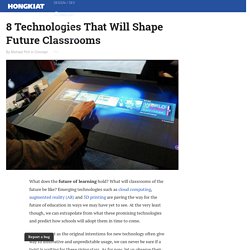
What will classrooms of the future be like? Emerging technologies such as cloud computing, augmented reality (AR) and 3D printing are paving the way for the future of education in ways we may have yet to see. At the very least though, we can extrapolate from what these promising technologies and predict how schools will adopt them in time to come. However, just as the original intentions for new technology often give way to innovative and unpredictable usage, we can never be sure if a twist is waiting for these rising stars. 20 Classroom Setups That Promote Thinking.
20 Classroom Setups That Promote Thinking.
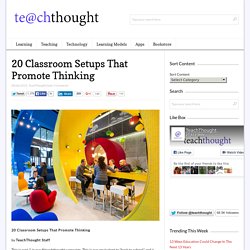
Reasons and Research – Why Schools Need Collaborative Learning Spaces. Creative Commons license image source We’ve converted a few classrooms to more collaborative spaces over the last few years at The College of Westchester, and faculty reaction has generally been quite positive.
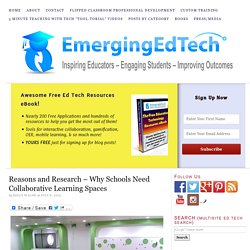
These initial room changes have revolved around modifying the layout of a few classrooms from the row-by-row footprint of the traditional lecture room to a more interactive, group-oriented layout of round tables. We are now looking to move towards the next iteration of this evolution by creating a technologically enabled space for collaborative learning. I had the good fortune of sitting through several sessions at the recent UB Tech conference focused on successful implementations of flexible learning spaces.
As a next step, I searched out and reviewed some of the many articles and resources available on the Web that focus on this topic. There are many reasons why collaborative, flexible learning spaces are advantageous. Reasons and Research – Why Schools Need C... De vill modernisera lärmiljöer. ”I en tid präglad av globalisering och tekniska revolutionen, är klassrummet inte längre den viktigaste platsen för inlärning, utan en av många.”
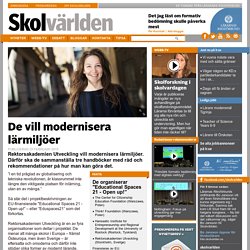
8 Tips and Tricks to Redesign Your Classroom. Editor's Note: Author David Bill is a designer and educator who consulted with The Third Teacher+ on the Remake Your Class project highlighted in the videos below.

The tips in this post go along with the companion video. We are excited by the simplicity (and low price tag!) Of this great redesign. Hope you'll share any of your own tips in the comments area below. If you're thinking of completing your own classroom remake project, good for you. A Place for Learning: The Physical Environment of Classrooms. I was supervising a teacher who was enrolled in our program at the University of Massachusetts Amherst that focused on developing student self-knowledge, ego strength, trust and community in classrooms.

We had created a manual with over 50 classroom lessons. She was teaching at a high school in an economically depressed district in northern Appalachia. She called me in a state of frustration. "I've used dozens of the exercises you guys developed, and they're not the least bit interested. There's no sense of community, and the trust level is non-existent. Students Take Ownership So I visited the class. I suggested that she ditch the exercises and work with the class to totally change the physical environment.
The Physical Environment Of The Classroom Matters For Learning. Tuesday, January 15, 2013 The classroom environment can affect a child’s academic progress over a year by as much as 25%, finds a new study: “The research, by professors at University of Salford in Britain, was carried out in seven schools in the Blackpool area.
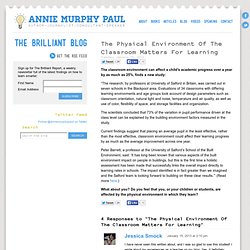
Evaluations of 34 classrooms with differing learning environments and age groups took account of design parameters such as classroom orientation, natural light and noise, temperature and air quality, as well as use of color, flexibility of space, and storage facilities and organization. The scientists concluded that 73% of the variation in pupil performance driven at the class level can be explained by the building environment factors measured in the study. Current findings suggest that placing an average pupil in the least effective, rather than the most effective, classroom environment could affect their learning progress by as much as the average improvement across one year.
Learning Environmentz by RAU. Här byggs nya Sannerudsskolan – utan klassrum. Work environment redesign. Executive Summary In the face of increasing competition and declining return on assets, companies often turn to short-term, one-time initiatives that (temporarily) improve their bottom lines.

While tactics such as cost-cutting may offer temporary relief, they don’t constitute a long-term strategy. We studied more than 75 companies to determine the key strategic operations differentiator and determined that to address increasing performance pressure, companies need to tap into the only resource with unlimited potential—their talent. On-the-job learning and talent development provide an effective and sustainable way to accelerate performance improvement at individual, team, organization, and ecosystem levels. Explore the work environment redesign case studies (interactive) Goal 1—Define high-impact challenges: Help workers and teams to focus on areas of highest business impact, learning, and sustainable improvement Goal 3—Amplify impact: Augment worker impact with the right infrastructure.
If students designed their own schools... Designing a New Learning Environment. What constitutes learning in the 21st century?
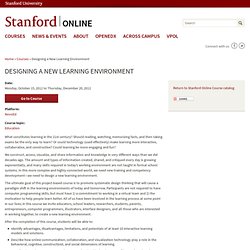
Should reading, watching, memorizing facts, and then taking exams be the only way to learn? 5 take-aways to improve learning conditions through spaces. What can 300$ per class do to improve learning?
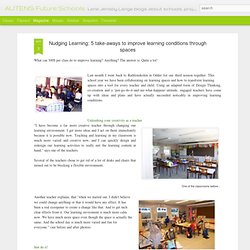
Anything? The answer is: Quite a lot! Last month I went back to Rathlouskolen in Odder for our third session together. This school year we have been collaborating on learning spaces and how to transform learning spaces into a tool for every teacher and child. Using an adapted form of Design Thinking, co-creation and a 'just-go-do-it-and-see-what-happens'-attitude, engaged teachers have come up with ideas and plans and have actually succeeded noticably in improving learning conditions. Another teacher explains, that "when we started out, I didn't believe we could change anything or that it would have any effect. Just do it! A fifth grade teacher told that in her classroom, she put up a small, simple divider near the end of a long table by the window. Lärmiljö Toltorpsskolan Mölndal 2013 Anna Sundqvist. The small changes in classroom environment that can improve learning.
Using light constructively can encourage a positive learning environment. Photograph: View Pictures/Universal Images Group Editorial We all know the spaces we live and work in affect us. We are likely to find soft colours soothing, clutter distracting and high temperatures soporific. But this idea may not be fully accepted when it comes to schools. Recently, the DfE stated: "There is no convincing evidence that spending enormous sums of money on school buildings leads to increased attainment. Of course teaching is central – but what if spending small amounts of money, or just doing things a bit differently at no extra cost, could make a real difference to students' attainment? Ante Runnquist's profile. The "Reggio Approach" to 0-99 Education: Redefining Schools as Community Learning Centers. Community Learning Rooms in the Loris Malaguzzi Center, Reggio Emilia, Italy. An exploration in light, sound, and creativity. Photo by Adam Provost (2013)
DATORN i UTBILDNINGEN.